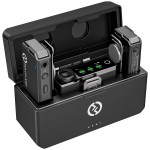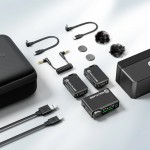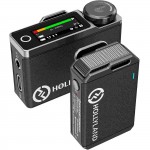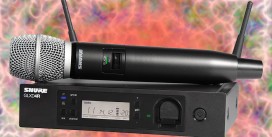The Hollyland Lark Max is a compact 2-person wireless lavalier kit aimed at vloggers, videographers, and content creators. It includes two clip-on transmitters or mics and a single receiver with a built-in display, all housed in a charging case. It is a new all in one system with an improved capsule design and active noise cancellation. Each tiny transmitter even has 8GB of internal storage of uncompressed WAV for backup recording. And what you get is very clean, detailed audio, (which could beat even more expensive systems) and a reliable link up to hundreds of feet. The Lark Max isn’t just about audio quality, but also battery life and intuitive design. It definitely has a premium feel: the metal-lined case lights up when opened like an Apple product – and has all the accessories you may need, ie. windscreens, magnetic shirt clips, cables/adapters for phones and cameras.
Design and Build
All in all the Lark Max feels like it’s built to last – a very solid kit, unlike most of those flimsier, budget lav mics around there. Each transmitter is a small, rectangular clip-on unit with a metal clip on the back and a stylish woven mesh windscreen. The mics are easy to handle and fairly rugged – the metal mic guard is stronger than the delicate capsules on some rivals even when the same price range is considered. Although it still does use plastic in its design, because obviously you don’t to wear a cement brick on your collar – yet it looks well made and of high quality, so no issues here. The charging case is surprisingly sturdy: it’s like a large AirPods case with new features, and of course it charges the transmitter batteries. And there is an interior pocket for all the cables and a second set of windscreens.
In terms of layout, the receiver is a bit larger than tiny keychain-style units. It has a belt/strap clip and is roughly the size of a camera hot‑shoe (so it can mount on a camera). This larger size lets Hollyland pack in an LCD screen, a push/pull dial, a Back button, and a 3.5 mm headphone jack. One minor gripe is that the hot-shoe mount on the receiver only works facing backwards, so on some cameras you may need a 90° adapter. Each transmitter has its own single control button and LEDs, and I found them easy to attach to clothing with the metal clip or included magnetic clips. Overall, the package feels thoughtful and road worthy: the magnets on the transmitters remind those of higher-end gear and I mean the pro lavs, and I also like the dead‑cat windshields that fit just right onto the capsules.
Audio Quality
The Lark Max’s headline feature is definitely its sound. In our tests it delivered warm, clear voice capture with very low noise. Once again, it’s not an exaggeration to say that it’s comparable to higher end lav systems, potentially beating more expensive mics when it comes to audio quality too. Because we’ve already previously reviewed their ‘budget’ model and it left us pleasantly surprised, but this? – This is an even bigger step up! Speech comes through natural and crisp, with no obvious distortion even at higher volumes. I didn’t notice any electronic hiss or tonal colorations. Outdoors, the built-in Environmental noise cancellation does an impressive job: background hums and winds are pulled down significantly so your voice stays more dominant. Even something atrocious like a clunky truck passing by or construction noise in the background in actuality has had quite little impact.
When comparing to a camera’s onboard mics, the difference is night-and-day: even at moderate distances the Lark’s 24-bit/48 kHz recording is consistently clear. Inside a quiet room or studio, it holds up just as well – the frequency response is broad (Hollyland quotes 70 dB SNR and 128 dB SPL handling), so it picks up subtle nuances without clipping. If anything, voice recordings feel slightly fuller than some competitors. And once again another surprise is that even on noisy city streets or busy events, the mic remains intelligible. We also borrowed it to one of our colleagues who noted when shooting downtown with obstacles, the Lark Max “was able to transmit audio clearly” even without a perfectly clear line of sight. So yeah, overall we find the audio performance to be the Lark Max’s strongest suit – consistent with what others would call solid or even impressively clear.
Wireless Range and Connectivity
On paper the Lark Max promises a very long range: Hollyland advertises up to 250 m (820 ft) line-of-sight. In practice you’ll rarely need that much. We tested it up to ~200 ft (outdoors, open area) and didn’t drop the link. I also did a quick research to see how consistent our findings with what other users reports and some user on Amazon even described a live 800+ ft range through walls in a glass building – though that was a very favorable case with nothing between transmitter and receiver. Indoors or with obstructions, performance is still very good: DIY Photography measured about 60 m (200 ft) reliable LOS.
The Lark Max uses a 2.4 GHz FHSS (frequency-hopping) wireless link – essentially its own Wi‑Fi channel – rather than Bluetooth or DECT. In congested RF environments this seems robust: Hollyland’s tests showed it handled lots of other 2.4 GHz devices with no major dropouts. In my trials around Wi-Fi routers and cellphones, I didn’t notice any pops or static unless the transmitters went completely out of sight. That said, unlike some pro UHF systems or military-style links, it can potentially struggle if overwhelmed by 2.4GHz noise. The system does include automatic frequency-hopping to try to avoid conflict, and in practice the solid build seems to handle normal use just fine.
By design the Lark Max offers no Bluetooth output – it won’t act as a Bluetooth headset. All connections to cameras or phones are done via wired cables or adapters. It comes with a suite of cables (TRS for DSLR, Lightning and USB-C for phones, USB-C to computer) so it can plug directly into most devices. On the camera end, the receiver has a 3.5 mm mono output (any mic input or TRRS adapter works). There’s also a convenient headphone jack on the receiver for live monitoring. In short, the connectivity is flexible: you can send the mic audio into a camera, phone, computer, or record internally on the device itself. Just don’t expect any wireless smartphone pairings – you must plug a cable into your device or use the internal recorder for capture.
Controls and Usability
The Lark Max is straightforward to use once you learn the menu. The receiver has a color OLED screen and a dial (plus a touch-sensitive wheel) for navigation. On power-up it auto-pairs with both mics (especially once you open the case lid). The main display shows battery levels, volume/gain levels for each mic, active modes (Mono/Stereo/Noise Cancelling) and signal strength. You can tap or turn the dial to change gain on each channel, mute, or activate the ENC noise filter right from the receiver without any app.
Each transmitter also has one multifunction button and lights. You can turn them on/off, mute them, or even start/stop their internal recording directly from the mics themselves. This is handy for solo shooters, since each talent can control their mic. The menus for mode selection (Mono vs. Stereo vs. Safety Channel mode) are logical. In Stereo mode each mic goes to its own channel (useful for two-talkers). In Safety mode the second channel records the same audio at a lower gain as a backup (useful if someone suddenly shouts). These modes are a nice touch – and yes, it’s the first time we’ve seen gain control on a safety track. In practice I left it in Stereo mode, but it’s nice to know the backup is there.
Setup is mostly plug‑and‑go. You power up, clip on or pin on the transmitters, and plug the receiver into your camera/phone. The receivers/transmitters remember each other’s sync once paired. If anything is confusing at first, the clear on-screen display and logical options make it easy to figure out. I especially liked that the included charging case automatically pairs the devices as soon as you open it, so you’re ready to go by the time you hand the mics to your presenters.
Battery Life and Charging
Battery performance on the Lark Max is very solid. Each transmitter’s internal Li-ion battery lasts about 7.5 hours per charge, and the receiver is rated around 9 hours. In my own shooting, a single day’s worth of use (8+ hours) was easily covered. The charging case is the real multiplier: it holds enough power to recharge both transmitters twice and the receiver once, meaning on the road you essentially have 3 full days of runtime in one pack. It takes roughly 2 hours to fully charge the set in the case.
As a result, we can say that the battery life also makes a very strong point, with 22-hour battery life (counting the case top-ups), it is a pro to be highlighted. To give context, Hollyland’s own blog compares it to DJI’s system: Lark Max’s 7.5h TX per charge beats DJI Mic’s 5.5h, and with the case yields about 15 hours of continuous TX power. Practically speaking, I could shoot all morning on one charge, pop the units back into the case at lunch, and head out again for afternoon interviews. The case is light and has clear LED indicators so you always know when everything is topped off. And btw, if you use the auto-record safety feature, you can even have the mics start recording on boot, so you never miss a take.
Internal Recording & Safety Features
 A unique aspect of the Lark Max is its built-in recording capability. Each transmitter can record locally to its 8GB flash as a backup. If the wireless link were to drop, you still have your audio on the mic. Transferring those files is easy – just plug the mic into a computer via USB and it appears like a flash drive. In my tests I recorded to the camera and to the mics simultaneously (the auto-record mode can do this), giving me two identical WAV files to match in post. For professional use especially this safety net is extremely valuable: I bet many would call it a “life saver” to have two copies of audio.
A unique aspect of the Lark Max is its built-in recording capability. Each transmitter can record locally to its 8GB flash as a backup. If the wireless link were to drop, you still have your audio on the mic. Transferring those files is easy – just plug the mic into a computer via USB and it appears like a flash drive. In my tests I recorded to the camera and to the mics simultaneously (the auto-record mode can do this), giving me two identical WAV files to match in post. For professional use especially this safety net is extremely valuable: I bet many would call it a “life saver” to have two copies of audio.
The receiver also offers a dedicated “Safety Channel” mode: this records the same mic signal at a lower gain on channel 2, so if channel 1 clips on a loud outburst, channel 2 can still have a clean take. This was a first for me on such a small kit and is a clever professional feature. Overall these safety features (dual-track recording and internal backups) give great peace of mind. And it’s not just marketing – in recording some of our samples it has shown how even with a loud noise or partial dropouts, the Lark Max still preserved usable audio on the alternate track.
Practical Use and Performance
In real-world shooting, the Lark Max proved flexible and reliable. Clipping on the tiny mics is simple (the 32 g transmitters are hardly noticed by the wearer) and the magnetic mounts are convenient for shirt, collar or lapel. Switching between on-camera use and phone is just swapping cables; I plugged it into my DSLR for an interview and it worked flawlessly. Out in a busy street, noise cancelling mode made voices pop out of the ambient noise, then tried it in a busy cafe and once again it left me surprised in a good way, so for those who wonder, it’s not just mechanical or machinery noise that it is able to cancel out.
During an event Lark Max’s receivers quickly auto-paired when I opened the case lid – and by the time people had cameras on, the system was synced and ready. The OLED display lets you confirm levels on the fly and I found it handy. Monitoring via headphones was straightforward as well; I could adjust a transmitter’s gain from the receiver while watching input meters. In a wedding shoot, for example, I clipped one mic to the groom, one to the videographer, and got very clean audio on both. For podcasters or livestreamers, it even works as a ‘USB mic’: if your Zoom calls sound like crap, you’ll find this really impressive as your voice turns crisper and sharper. Finally, the included carry case is tight and protective, so I could toss it in a camera bag without worrying, integrating it very easy into my typical setups.
Conclusion
After using the Lark Max extensively, I can say it lives up to the buzz. It delivers studio-like audio with very few compromises, at a budget-friendly price. Setup is plug-and-play and the extra safety features like internal recording, safety channel and noise cancel are real-world game‑changers that you usually see implemented this well only in more expensive gear. Leaving us impressed, The Hollyland Lark Max earns its high ratings, and for an average user this is going to translate to no less than simply exceeding expectations. In short, it’s a standout wireless lavalier system for filmmakers, vloggers, and podcasters alike. Highly recommended for anyone needing reliable two-person audio on a budget!
Pros
|
Cons (minor)
|












